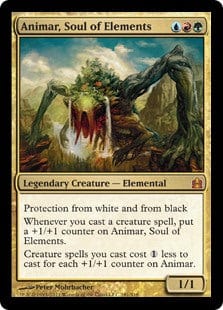Which version of Niv-Mizzet makes the better commander: Niv-Mizzet, the Firemind or Niv-Mizzet, Dracogenius?


For many, the answer is likely the Firemind. After all, it's one half of a near-infinite combo with Curiosity or Ophidian Eye. Plus, it works great with any number of wheel effects, many of which exist in Magic's Commander format.
Niv-Mizzet, Dracogenius, on the other hand, offers far less synergy than his predecessor. Though he's a bit bigger, he doesn't interact with draw spells, he offers no two-card combo kills, and he's mana intensive.
So what might make the Dracogenius a better commander than the Firemind? Perceived threat level.
Let's imagine there's a one to ten scale of how threatening any given commander is. At one, we're talking about cards that either help other players or look underpowered. Examples include Pheldagrif, General Jarkeld, and most of the commanders from Legends.


A ten on our perceived threat level scale is a commander that just looks terrifying. These cards often carry a reputation for ending games suddenly or being a pain to deal with. Think Animar, Soul of Elements, Breya, Etherium Shaper, or Rafiq of the Many.



Everyone knows these cards are powerful and will therefore target you for playing them. This actually makes them slightly worse as commanders. Conversely, everyone knows cards like General Jarkeld are bad, which actually makes them a bit better.
For example, I once built a Narset, Enlightened Master deck which, instead of casting extra turn and extra combat step spells, dumped planeswalkers onto the board for free. Though it was still a pretty solid deck, I certainly wouldn't describe it as broken. Rather, it was a different take on Narset. But when I showed it to my friends, they all groaned.

"Don't worry," I assured them. "It's not what it looks like. I don't have any extra turn spells, no extra combat cards. Nothing broken like that. This deck has Dovin Baan in it, for Garfield's sake. How bad can it be?"
Didn't matter. Narset and I were dead five turns later. And when I asked my friends why they targeted me, they shrugged and said, "Because you're playing Narset."
Wham. That's perceived threat level.
Commander players know which commanders have a reputation for brokenness. They won't hesitate to attack you for playing those cards, even if you haven't done anything egregious within the game itself. And no matter how good your broken commander might be, it's going to struggle in a three-on-one game.
This is why I'd rather play Dracogenius than Firemind. The former draws so much less hate. It looks rather innocuous, especially in comparison with its other version. And when you play a commander that looks weak, people will often leave you alone. After all, why mess with your stuff when a Kaalia of the Vast player is sitting right next to you?
When choosing your commander, keep perceived threat level in mind. To anticipate how much hate your commander might draw, check EDHREC's list of top commanders. The ones near the top tend to have high PTL ratings.
Of course, this might also depend on your individual meta. Some cards might have a low PTL when you start playing them, but might gradually draw more hate once people see how good they are. It's certainly not a fixed scale, and it varies depending on who you're playing with.
Whether you're on Team Firemind or Team Dracogenius, keep perceived threat level in mind. You never know when it might come up.
Kyle Massa is a writer and avid Magic player living in upstate New York with his fiancée and their two cats. When he's not writing, you'll find him down at the East Greenbush FlipSide store jamming booster drafts. For more of Kyle's work, visit www.kyleamassa.com.










